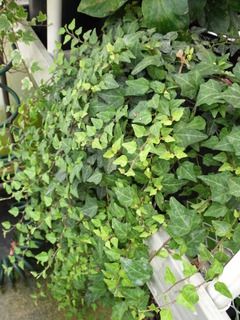
English Ivy is a good choice for forgetful-waterers. It prefers to be watered thoroughly every couple of days, drying out in between, but will tolerate dryer conditions than most houseplants. When the plant is at its limit the leaves will take on a grayish cast; those leaves will begin to get crispy and will easily break off the plant. While this isnít something you want have happen to your plant, it is okay because the plant can always be cut back and fresh growth will emerge.
I recommend fertilizing English Ivy at every other watering when it is actively growing, and not at all when it is resting. If you see it regularly putting out new leaves, continue fertilizing. If it seems to be ďstuckĒ and not growing, keep watering to a minimum and don't fertilize at all. Keep an eye out for any white, crusty materials that may accumulate, as they indicate that the plant is getting more than enough fertilizer. If this happens, flush the pot out repeatedly with clear water and cut back on how often you fertilize.
English Ivy needs to be pinched back every so often to give it fullness and a nice shape; this is a great opportunity to start another plant. It is very easy to propagate English Ivy. Cuttings can be taken at any time, but preferably when the plant is actively growing. Root cuttings in a lightweight medium with or without rooting hormone. Covering the rooting cuttings with a sheet of plastic wrap until roots have developed will increase success.
There is research indicating that English Ivy is an excellent natural air filter. Studies have shown that it effectively removes airborne mold spores and pet waste particles from the air. It is also ranked in the top 10 air-cleaning plants by NASA because it is so efficient at removing harmful chemicals, such as benzene, from the air.


